Biodiversiteit
Kijfgracht
Verkademeisje.nl
Dolphins
Dolphins categorie
Dolphins and me

(c) MvdH, 1987
-
This page contains pictures taken by a variety of persons who accompanied me on trips around the world to look for dolphins and whales
-
They have been placed in chronological order
-
I have listed each photographer's credit and/or websitelink below the picture
-
Marije van der Hoeven gets a special mention, she took all the beautiful black and white photos of me and the dolphins in human care.

(c) MvdH, 1987

(c) MvdH, 1987
With Fungi in 1989, 1990 and 1991 (Dingle Bay, Ireland)
photos: (c) Fungi Productions



photo (c) Andy Eastwood.
Still from the clip 'Beautiful Love'

(c) Sean Mannion 1989, see also the booklet
'Fungie, Ireland's Friendly Dolphin'

(c) Fungi Productions 1989

(c) MvdH, 1993
Dolphin Reef Eilat, Israel, 1993
(c) Fungi Productions
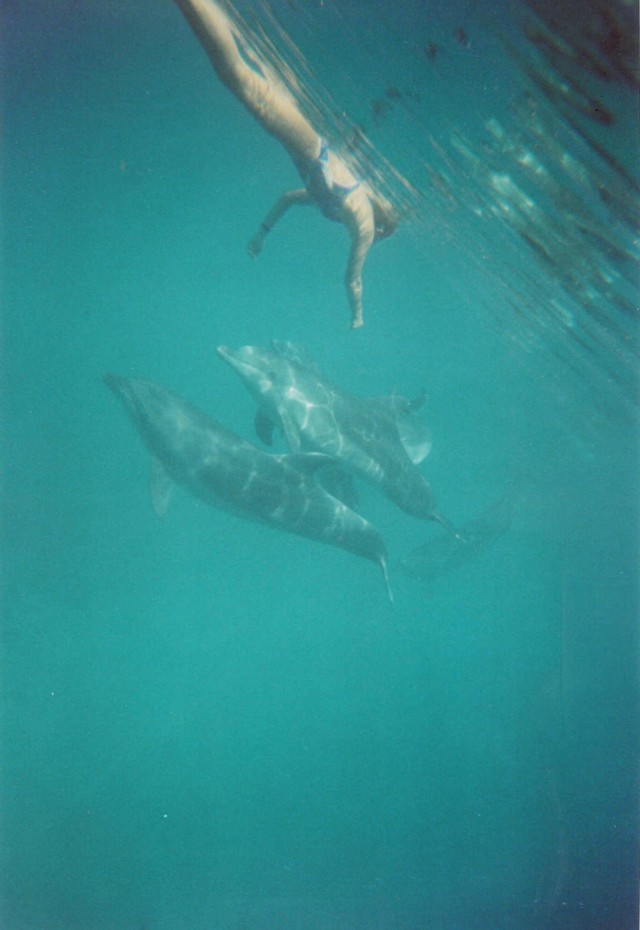

With dolphins in human care
(c) MvdH, 1994
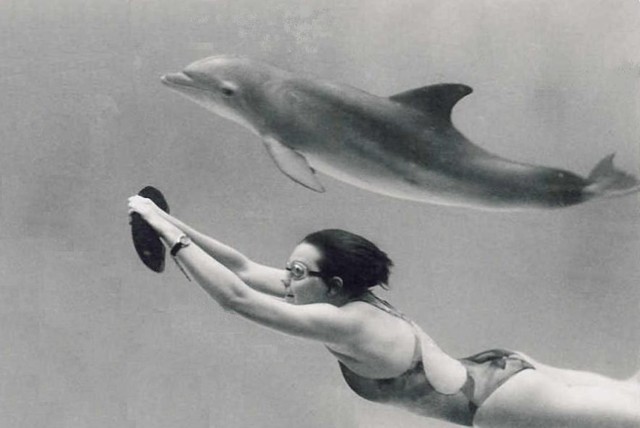


In 1995, with shortfinned pilot whales
off Tenerife (Canary Isles, Spain),
(c) Dario & Marian







Waiting eagerly for a fish from the trainer!
The two pictures below were
made by professional photographer
Martijn de Jonge

'Toto', ambassador dolphin in Tholen, NL, 2007

there she is!
Wild dolphins and whales
Welcome to the page on dolphins and whales
I've made separate pages about wild dolphins and dolphins in human care, please use the menu on the left or the linked words in the text below to navigate.

Atllantic spotted dolphins (Stenella frontalis) off La Gomera (2004).
See wild dolphins in Europe

Shortfinned pilot whales being observed by tourists off Tenerife, Canary Isles (1995)
Sometimes, wild dophins and whales choose to live in an area with lots of people.
Some individuals might even leave their pods and interact with humans as if they were their pod-members. Such animals are called 'ambassadors' (for their species).
There is a separate page on ambassador's dolphins in general.
An example is Fungi, the Dingle Dolphin, in Ireland.
See the website on Irish Dolphins for the most recent information on Fungi.

Fungi and me in 1989
(c) Fungi Productions

Click here for pictures of dolphins in human care
Dolphins in human care

I've visited lots of aquariums, oceanariums and zoos which house cetaceans.
Here are some pictures I took in establishments in Europe. Enjoy!





Recreational Freediving



On this page you will find an introduction to
the Recreational Freedive Meets in Beverwijk (RFMB)
- an explanation about (recreational) freediving, the risks and joys
- an account of the first and second RFMB in the Netherlands, in 2003 and 2004
- and lots of photos accompanying the story of both RFMBs
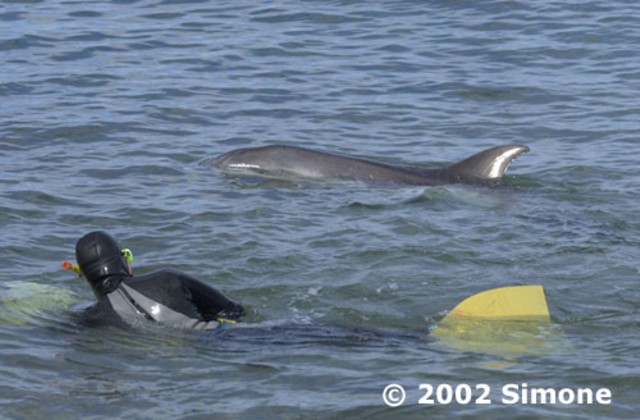
Jan Ploeg, waterwingspecialist, with his 'trainer' and companion Dusty (Ireland)
Introduction to the RFMB
Recreational Freediving - more specific the Recreational Freedive Meet Beverwijk or RFMB - saw the light after AIDA Netherlands freedivers Aaf and Arnoud met during trainingsessions in a pool.
We both realized holding our breaths and counting the minutes was not triggering deeper emotions. But swimming with dolphins respectively donning a mermaidcostume and living the life like that, did indeed rock our boats!
We brainstormed and got a great response from AIDA Netherlands to organize the first RFMB in January 2003.
The next year, even more specialists were attracted and this page will give you an impression of this great event.
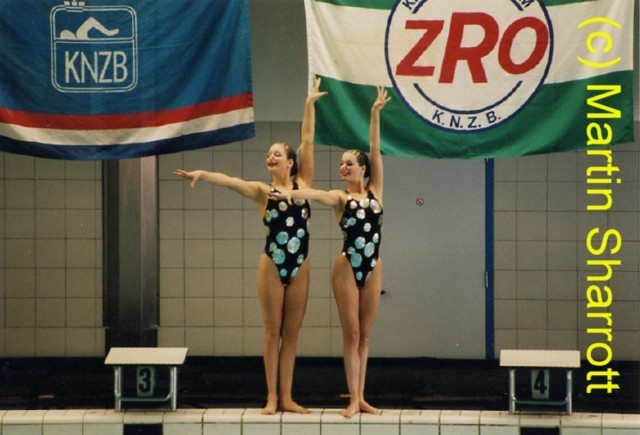
Our main sponsor was The Printer, with facilities in various places in the Netherlands. Check http://www.gadget-printer.nl/website/ for more information on printing A0 (big, big posters on hardboard), t-shirts, programme-booklets and much more.
Kitty Snel has a beautiful webpage on recreational freediving and mermaid experiences. Go to http://www.freemerfolk.nl/ for in-depth information.

WHAT IS RECREATIONAL FREEDIVING?
To be able to answer this question, we’d better try and explain the term ‘freediving’ first. Many of us have already discovered, that diving is a fascinating and relaxing sport. With the aid of an aqualong, the diver can stay under water for a long time.
Instead of using an extra supply of air, a freediver only uses the air already present in the lungs. This discipline is therefore the oldest diving discipline; for centuries, pearldivers and spearfishers have had to work underwater without any extra machinery to prolong their divetime.
Nowadays, freediving has become more of a ‘sport’; an increasing number of athletes train together and try to set records by holding their breath or diving as deep as possible.

Modern freediving recognizes eight disciplines, which are divided into the ‘pool’ and the ‘outdoors’ varieties. The main goals are: to stay submerged for as long as possible (static), to swim a very long distance underwater (dynamic) or to dive as deep as possible. Those deep dives have become well known through the media attention they attract. Also, movies like “The Big Blue” and “Oceanmen” give a good example of the the world of the deepdiving freedivers.
The Recreational Freediver practises one of the eight disciplines without pursuing any goals. But the true recreational freediver, is recognized because of his dismissal of the importance of time, measurement tape, lines and distances. No other swimmer knows how wonderful this free feeling really is, whilst swimming in the vertical watercolumn, without any goals and feeling as elegant and supremely adapted to the aquatic environment as a marine mammal.

Marine mammals, especially whales and dolphins, are our role models. Although in no way we are able to imitate their suppleness and grace, nor their speed, we can try and copy their movements. Aided by a ‘monofin’ (one fin for both feet), a freediver is able to feel the ‘sinusmovement’ a dolphin makes.

In the Netherlands, we have only one ‘homo dolphinus’, a man who, through years of studying and living with dolphins, has learnt special techniques of swimming like one. You can get to know his way of life by surfing to www.janploeg.nl.
Because Jan is the only one in the Netherlands, who is so extremely well adapted to the water and a true freediver, he has been our special guest and workshop-teacher at both RFMB's.
RISKS
Most sports organizations (including freedivers) and the general public regard freediving as an extreme sport. Certainly, there are risks involved, especially because in regular freediving, new limits of the human body are sought after, time and again. Although the recreational variety might seem less spectacular, that doesn’t mean practising it is without risks. Freediving without good education is perilous anyway – it can even lead to injuries and death. Therefore, a good education by a certified organization is obligatory if you want to safely practise underwatersports. Unfortunately, in the Netherlands only regular freediving is instructed. We, recreational freedivers, do however advise you to follow their course if you want to become a (recreational) freediver. For more information on courses, check it on www.immersion.nu.

The first Recreational Freedive Meet in 2003
We have been wanting to share our passion as recreational freedivers with other, likeminded people for years. The result of brainstorming for years about this, was the first Recreational Freedive Meet, held on january 18th, 2003. This day was organized with the idea that it would be a great way to see if there was any interest in our variety of freediving. This Meet of ‘freediving in an alternative way’ led to the participation of 35 persons who were very enthousiastic and appreciative of our hard work of organizing the day.

Especially our specialist Jan Ploeg had his hands full, demonstrating his invention (called ‘waterwing’) to the visitors. With monofin, waterwing and even a dorsal fin (it works like magic!), Jan spent more time below the surface than above. Thankfully, he had brought a number of different waterwings, so everybody could give this wonderful technique of manouvring up and down a try.
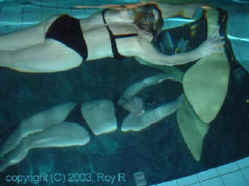
The ‘mirrorlane’–25 metres long- was the best part of the Meet yet: this ‘fourth’ dimension turned out to be a wonderful way to monitor your swimming technique.
People wanting to get an idea of their manouvrability and expertise with monofin, were given the opportunity to swim through an underwatertunnel. Six half-hoops simulated a tunnel; with the monofin you had to keep swimming at one depth, move your legs only sparsely and above all, keep your body in one line: there was only a small margin of a couple of centimetres next to the monofin! Even the best specialists had a hard time; most of the swimmers ended up with three or more hoops around their fin!!

After the ‘wet’ part, the pancakebuffet was a wonderful treat. The crew of Pancakeship ‘Het Schip’ had heard our grumbling stomachs; an infinite buffet with a huge number of incredible toppings was available to us for hours.
The Second RFMB
From the comments in our guestbook and many positive e-mailmessages after the Meet, we learned that the enthousiasm and interest for a second Meet was huge.
We, the organizers are therefore very glad to let you know we succeeded in organizing the Second Recreational Freedive Meet Beverwijk. It was held on Saturday, January 17th, 2004, in the public swimmingpool of Beverwijk.
The Specialists in 2004
Of course, Jan Ploeg gave another demonstration and taught his techniques at the workshops; the mirrorlane was in place for that extra dimension.
But, there was more! Specialists Nicole Voet and Edwin Kanters taught pupils to deal with a monofin.

To get the hang of the basics of board-jumping, Wessel and Marga Zimmermann came to the Meet to show their art - and give some helpful suggestions. Check their school out on www.springschool.nl.

Marga Zimmermann giving instructions

Wessel Zimmermann giving instructions
Furthermore, Melanie and Kimberly Whittington, two enthousiastic synchronize-swimmers gave a demonstration, followed by a workshop.

For those, who have never freedived before, an introduction course was obligatory and cost 10 euros (entrance fee to the Meet is also 10 euros; total = 20 euros) It was given by two certified AIDA International instructors, who are experienced recreational freedivers as well. The introduction course was in English, but that wasn't a problem for anyone.
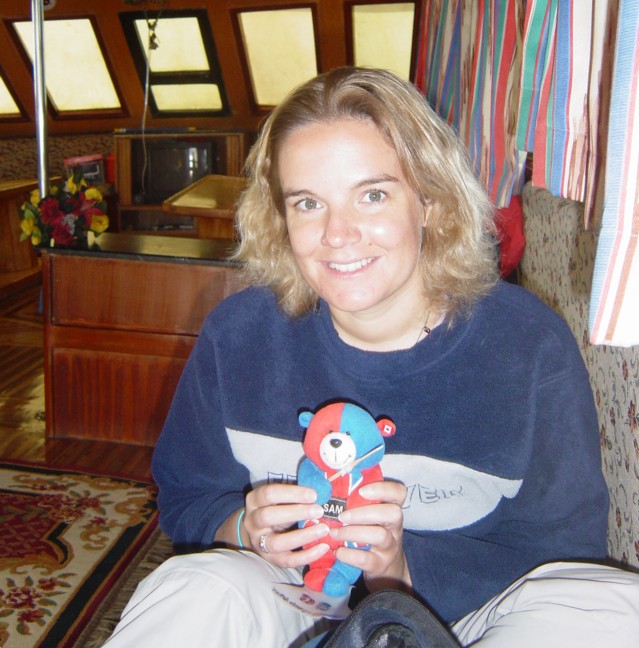
Sam was one of the AIDA instructors, flown in especially from the UK.
In her hands 'the Deepest Bear', going with her everywhere -also underwater!
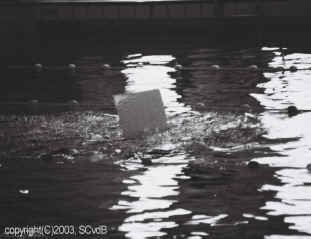
to freediving in the 'grachten' of the Havenwijk in Leiden (meeting pike, carp and lots more fishes!)








